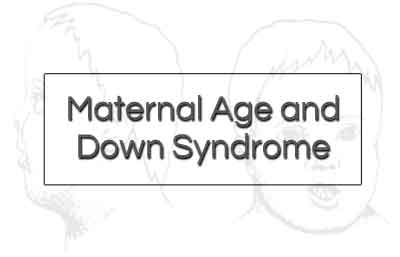- Home
- Editorial
- News
- Practice Guidelines
- Anesthesiology Guidelines
- Cancer Guidelines
- Cardiac Sciences Guidelines
- Critical Care Guidelines
- Dentistry Guidelines
- Dermatology Guidelines
- Diabetes and Endo Guidelines
- Diagnostics Guidelines
- ENT Guidelines
- Featured Practice Guidelines
- Gastroenterology Guidelines
- Geriatrics Guidelines
- Medicine Guidelines
- Nephrology Guidelines
- Neurosciences Guidelines
- Obs and Gynae Guidelines
- Ophthalmology Guidelines
- Orthopaedics Guidelines
- Paediatrics Guidelines
- Psychiatry Guidelines
- Pulmonology Guidelines
- Radiology Guidelines
- Surgery Guidelines
- Urology Guidelines
Maternal Age above 35 increases risk of Down Syndrome: Metropolis Healthcare Study

Mumbai : Down syndrome is a genetic disorder that causes mental retardation and abnormal physical growth. Down syndrome occurs when an individual has a full or partial extra copy of chromosome 21 (trisomy 21). Down syndrome increases risk for certain medical conditions such as congenital heart defects, respiratory, hearing problems, childhood leukemia, and thyroid conditions. It affects about 1 in 800 babies worldwide and in India every year more than 23,000 babies are born with Down syndrome.
Prenatal screening is necessary to reveal disorder or conditions that affect the fetus and help improve outcome of pregnancy. There are two types of prenatal screening that are available; Noninvasive Methods like Ultrasonography and Biochemical (blood) test like Dual marker test in the first trimester (8 to 13.6 weeks gestation age) and quadruple marker test in the second trimester (14 to 22.6 weeks). The other type of screening is Invasive procedures like Chorionic Villous Sampling and Amniocentesis.
March 21st is observed as World Down’s Syndrome Day. In order to understand the intensity of the chromosomal disorder in India, Metropolis Healthcare Ltd, the Pathology Specialist, conducted a comprehensive study on 23,132 prenatal screening samples processed between July 2016 and December 2016.
A prenatal biochemical marker analysis of over 23,132 samples (maternal blood) revealed that over 6.29% of samples were at a high risk of Down Syndrome. The increasing trend of late marriages and delayed first pregnancy that usually occurs between the age group of 31-35 years increases the risk of having a baby born with this syndrome.
The study reveals a worrying trend in the age group of 31-35 years. Out of 7411 samples studied, 6.68% denotes the risk of Down’s syndrome pregnancies. Over 16% of samples tested between age group of 36-40 were at risk and a whopping 43% in the age group of 41-45 exhibited high risk.
Trisomy 21 Screening by Biochemical markers Test (6 month data)
| Age Group | High Risk | No risk | Grand Total | % Positivity |
| 21 to 25 | 117 | 3595 | 3712 | 3.15 |
| 26 to 30 | 329 | 9098 | 9427 | 3.49 |
| 31 to 35 | 495 | 6916 | 7411 | 6.68 |
| 36 to 40 | 390 | 1967 | 2357 | 16.55 |
| 41 to 45 | 131 | 174 | 305 | 42.95 |
| Grand Total | 1462 | 21750 | 23212 | 6.30 |
Adding on the study Dr. Deepak Sanghavi, Deputy Chief of Lab Services, Metropolis Healthcare Limited, Mumbai said, “Down’s syndrome is a genetic condition where the child has an extra copy of the 21st chromosome. With the increase in the maternal age, the likelihood of having a child affected with Down’s syndrome increases considerably. A woman who is 40 years old at the time of conceiving a child is at a 16 times greater risk of giving birth to a baby affected with Down’s syndrome, as compared to a woman who conceives at the age of 25.”
It must be noted that The ACOG (American College of Obstetrician and Gynecologist) Guideline 2007 recommends that every pregnant woman regardless of Age needs to be screened for Downs Syndrome.
All the screened positive (High risk) cases by the statistical calculation needs to be confirmed by Invasive procedures like Chorionic Villous sampling in first trimester and Amniocentesis in Second trimester. It must be noted that tests that come positive in Dual and Quadruple test may not come positive in Amniocentesis.
Chorionic villus sampling (CVS) is a prenatal test in which a sample of chorionic villi is removed from the placenta for testing. The sample can be taken through the cervix (transcervical) or the abdominal wall (transabdominal). During pregnancy, the placenta provides oxygen and nutrients to the growing baby and removes waste products from the baby's blood. The chorionic villi are wispy projections of placental tissue that share the baby's genetic makeup.
Amniocentesis is a procedure in which amniotic fluid is removed from the uterus for testing or treatment. Amniotic fluid is the fluid that surrounds and protects a baby during pregnancy. This fluid contains fetal cells and various chemicals produced by the baby. This is an invasive procedure and it is important to understand the risks and be prepared for the results.

Disclaimer: This site is primarily intended for healthcare professionals. Any content/information on this website does not replace the advice of medical and/or health professionals and should not be construed as medical/diagnostic advice/endorsement or prescription. Use of this site is subject to our terms of use, privacy policy, advertisement policy. © 2020 Minerva Medical Treatment Pvt Ltd